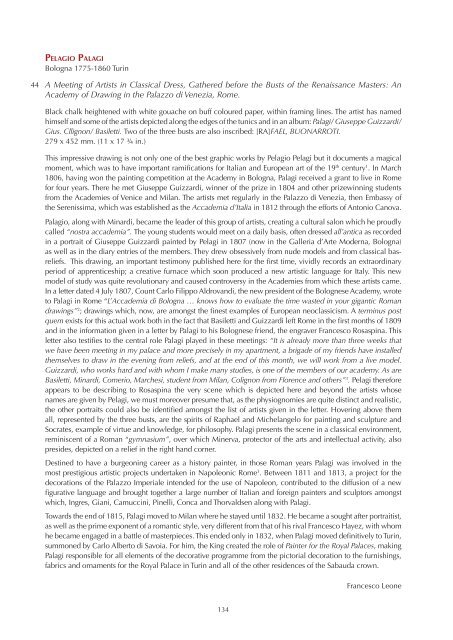Catalogue-2014-Jean-Luc-Baroni
- No tags were found...
Create successful ePaper yourself
Turn your PDF publications into a flip-book with our unique Google optimized e-Paper software.
44<br />
Pelagio Palagi<br />
Bologna 1775-1860 Turin<br />
A Meeting of Artists in Classical Dress, Gathered before the Busts of the Renaissance Masters: An<br />
Academy of Drawing in the Palazzo di Venezia, Rome.<br />
Black chalk heightened with white gouache on buff coloured paper, within framing lines. The artist has named<br />
himself and some of the artists depicted along the edges of the tunics and in an album: Palagi/ Giuseppe Guizzardi/<br />
Gius. Cllignon/ Basiletti. Two of the three busts are also inscribed: [RA]FAEL, BUONARROTI.<br />
279 x 452 mm. (11 x 17 ¾ in.)<br />
This impressive drawing is not only one of the best graphic works by Pelagio Pelagi but it documents a magical<br />
moment, which was to have important ramifications for Italian and European art of the 19 th century 1 . In March<br />
1806, having won the painting competition at the Academy in Bologna, Palagi received a grant to live in Rome<br />
for four years. There he met Giuseppe Guizzardi, winner of the prize in 1804 and other prizewinning students<br />
from the Academies of Venice and Milan. The artists met regularly in the Palazzo di Venezia, then Embassy of<br />
the Serenissima, which was established as the Accademia d’Italia in 1812 through the efforts of Antonio Canova.<br />
Palagio, along with Minardi, became the leader of this group of artists, creating a cultural salon which he proudly<br />
called “nostra accademia”. The young students would meet on a daily basis, often dressed all’antica as recorded<br />
in a portrait of Giuseppe Guizzardi painted by Pelagi in 1807 (now in the Galleria d’Arte Moderna, Bologna)<br />
as well as in the diary entries of the members. They drew obsessively from nude models and from classical basreliefs.<br />
This drawing, an important testimony published here for the first time, vividly records an extraordinary<br />
period of apprenticeship; a creative furnace which soon produced a new artistic language for Italy. This new<br />
model of study was quite revolutionary and caused controversy in the Academies from which these artists came.<br />
In a letter dated 4 July 1807, Count Carlo Filippo Aldrovandi, the new president of the Bolognese Academy, wrote<br />
to Palagi in Rome “L’Accademia di Bologna … knows how to evaluate the time wasted in your gigantic Roman<br />
drawings” 2 ; drawings which, now, are amongst the finest examples of European neoclassicism. A terminus post<br />
quem exists for this actual work both in the fact that Basiletti and Guizzardi left Rome in the first months of 1809<br />
and in the information given in a letter by Palagi to his Bolognese friend, the engraver Francesco Rosaspina. This<br />
letter also testifies to the central role Palagi played in these meetings: “It is already more than three weeks that<br />
we have been meeting in my palace and more precisely in my apartment, a brigade of my friends have installed<br />
themselves to draw in the evening from reliefs, and at the end of this month, we will work from a live model.<br />
Guizzardi, who works hard and with whom I make many studies, is one of the members of our academy. As are<br />
Basiletti, Minardi, Comerio, Marchesi, student from Milan, Colignon from Florence and others” 3 . Pelagi therefore<br />
appears to be describing to Rosaspina the very scene which is depicted here and beyond the artists whose<br />
names are given by Pelagi, we must moreover presume that, as the physiognomies are quite distinct and realistic,<br />
the other portraits could also be identified amongst the list of artists given in the letter. Hovering above them<br />
all, represented by the three busts, are the spirits of Raphael and Michelangelo for painting and sculpture and<br />
Socrates, example of virtue and knowledge, for philosophy. Palagi presents the scene in a classical environment,<br />
reminiscent of a Roman “gymnasium”, over which Minerva, protector of the arts and intellectual activity, also<br />
presides, depicted on a relief in the right hand corner.<br />
Destined to have a burgeoning career as a history painter, in those Roman years Palagi was involved in the<br />
most prestigious artistic projects undertaken in Napoleonic Rome 3 . Between 1811 and 1813, a project for the<br />
decorations of the Palazzo Imperiale intended for the use of Napoleon, contributed to the diffusion of a new<br />
figurative language and brought together a large number of Italian and foreign painters and sculptors amongst<br />
which, Ingres, Giani, Camuccini, Pinelli, Conca and Thorvaldsen along with Palagi.<br />
Towards the end of 1815, Palagi moved to Milan where he stayed until 1832. He became a sought after portraitist,<br />
as well as the prime exponent of a romantic style, very different from that of his rival Francesco Hayez, with whom<br />
he became engaged in a battle of masterpieces. This ended only in 1832, when Palagi moved definitively to Turin,<br />
summoned by Carlo Alberto di Savoia. For him, the King created the role of Painter for the Royal Palaces, making<br />
Palagi responsible for all elements of the decorative programme from the pictorial decoration to the furnishings,<br />
fabrics and ornaments for the Royal Palace in Turin and all of the other residences of the Sabauda crown.<br />
Francesco Leone<br />
134
















